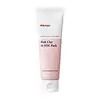What's inside
What's inside
 Key Ingredients
Key Ingredients

 Benefits
Benefits

 Concerns
Concerns

 Ingredients Side-by-side
Ingredients Side-by-side

Water
Skin ConditioningKaolin
AbrasiveGalactomyces Ferment Filtrate
HumectantGlycerin
HumectantCetearyl Alcohol
EmollientSalix Alba Bark Extract
AstringentCalamine
AbsorbentHelianthus Annuus Seed Oil
EmollientIsoamyl Laurate
EmollientWine Extract
AntioxidantRosa Canina Fruit Extract
AstringentDaucus Carota Sativa Root Extract
Skin ConditioningVitis Vinifera Seed Extract
AntimicrobialTitanium Dioxide
Cosmetic ColorantPotassium Olivoyl Hydrolyzed Oat Protein
CleansingGlyceryl Stearate
EmollientVitis Vinifera Seed Oil
EmollientCellulose
AbsorbentFragaria Ananassa Fruit Powder
Skin ConditioningGlyceryl Oleate
EmollientRosa Centifolia Flower Water
Skin ConditioningZanthoxylum Piperitum Fruit Extract
Skin ConditioningPulsatilla Koreana Extract
Skin ConditioningRosa Damascena Flower Oil
MaskingUsnea Barbata Extract
Phaseolus Radiatus Seed Extract
Skin ConditioningGlycyrrhiza Glabra Root Extract
BleachingMacadamia Integrifolia Seed Oil
Skin ConditioningCI 75470
Cosmetic ColorantAnthemis Nobilis Flower Oil
MaskingRosmarinus Officinalis Leaf Oil
MaskingWater, Kaolin, Galactomyces Ferment Filtrate, Glycerin, Cetearyl Alcohol, Salix Alba Bark Extract, Calamine, Helianthus Annuus Seed Oil, Isoamyl Laurate, Wine Extract, Rosa Canina Fruit Extract, Daucus Carota Sativa Root Extract, Vitis Vinifera Seed Extract, Titanium Dioxide, Potassium Olivoyl Hydrolyzed Oat Protein, Glyceryl Stearate, Vitis Vinifera Seed Oil, Cellulose, Fragaria Ananassa Fruit Powder, Glyceryl Oleate, Rosa Centifolia Flower Water, Zanthoxylum Piperitum Fruit Extract, Pulsatilla Koreana Extract, Rosa Damascena Flower Oil, Usnea Barbata Extract, Phaseolus Radiatus Seed Extract, Glycyrrhiza Glabra Root Extract, Macadamia Integrifolia Seed Oil, CI 75470, Anthemis Nobilis Flower Oil, Rosmarinus Officinalis Leaf Oil
Water
Skin ConditioningKaolin
AbrasiveDipropylene Glycol
HumectantBentonite
AbsorbentBetaine
HumectantSilica
AbrasiveButylene Glycol
HumectantMontmorillonite
Absorbent1,2-Hexanediol
Skin ConditioningIllite
AbrasiveHydroxyethyl Urea
HumectantHydroxyacetophenone
AntioxidantCellulose
AbsorbentXanthan Gum
EmulsifyingChromium Oxide Greens
Parfum
MaskingCitric Acid
BufferingCamellia Sinensis Leaf Extract
AntimicrobialDisodium EDTA
Ethylhexylglycerin
Skin ConditioningTocopherol
AntioxidantWater, Kaolin, Dipropylene Glycol, Bentonite, Betaine, Silica, Butylene Glycol, Montmorillonite, 1,2-Hexanediol, Illite, Hydroxyethyl Urea, Hydroxyacetophenone, Cellulose, Xanthan Gum, Chromium Oxide Greens, Parfum, Citric Acid, Camellia Sinensis Leaf Extract, Disodium EDTA, Ethylhexylglycerin, Tocopherol
Alternatives
Ingredients Explained
These ingredients are found in both products.
Ingredients higher up in an ingredient list are typically present in a larger amount.
Cellulose is the main component of plant cell walls. It is used as an emulsifier, absorbent, and texture enhancer.
This ingredient has many functions:
Fun fact: Cellulose is the most abundant form of organic polymer on Earth.
Learn more about CelluloseKaolin is a clay. It is used for oil control and to help minimize pores. Like other clays, kaolin has the ability to absorb excess sebum or oil. This can help clean out pores and mattify the skin.
Some types of kaolin may have exfoliating properties. When water is added to kaolin, it becomes a paste with small abrasive particles.
Most kaolin is a white color, but may be pink/orange/red depending on where it comes from.
The name 'kaolin' comes from a Chinese village named 'Gaoling'. Kaolin clay comes from rocks rich in kaolinite. Kaolinite, the mineral, has a silicate layered structure. Kaolinite is formed from chemical weathering of aluminum siilicate minerals.
Besides skincare, kaolin is commonly used to make glossy paper, in ceramics, toothpaste, and as medicine to soothe stomach issues.
Learn more about KaolinWater. It's the most common cosmetic ingredient of all. You'll usually see it at the top of ingredient lists, meaning that it makes up the largest part of the product.
So why is it so popular? Water most often acts as a solvent - this means that it helps dissolve other ingredients into the formulation.
You'll also recognize water as that liquid we all need to stay alive. If you see this, drink a glass of water. Stay hydrated!
Learn more about Water